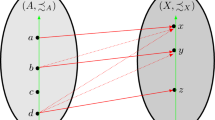Abstract
This paper considers hybrid systems which are continuous/discrete-time systems interacting with a decision maker which oversees the control and structure of the continuous/discrete-time system. These two segments combine with a processor which evaluates data to produce a three-segment model of a hybrid system having sufficient flexibility to represent a broad range of real-time situations and sufficient generality to incorporate the essential aspects of other models into a single framework. In particular the paper uses a graphically expressive controlled Petri net formulation of the decision maker and any of the usual models for the continuous/discrete-time system. Interaction between the systems occurs via three types of events: continuous/discrete-time events, decision-making events, and processor events. These types of events and their composition are rigorously defined to produce event structures and event histories. These events and event histories are used for the domain of interaction functions which specify the channels of communication between the three essential segments of the hybrid system. The event-based domains allow the disassociation of these communication channels from dependence on particular kinds of models or applications. The range of the interaction functions are binary vector-valued indicating the activation/deactivation processes in the respective segments. The entire modeling strategy is motivated by applications and models found in the literature especially flexible manufacturing systems and the C-net model of a hybrid system.
Similar content being viewed by others
References
Agerwala, T. 1979. Putting Petri nets to work.IEEE Comput. pp. 85–94.
Atabakhche, H., Simonetti Barbalho, D., Valette, R. and Courvoiser, M. 1986. From Petri net-based PLCs to knowledge-based control.Proc. IECON '86, Vol. 2, pp. 817–822.
Benvensiste, A., and Le Guernic, P. 1990. Hybrid dynamical systems theory and the SIGNAL language.IEEE Trans. Automat. Control. AC-35(5), pp. 535–546.
Brand, K., and Kopainsky, J. 1988. Principles and engineering of process control with Petri nets.IEEE Trans. Automat. Control. AC-33(2), pp. 138–149.
DeCarlo, R.A., Zak, S.H., and Matthews, G.P. 1988. Variable structure control of nonlinear multivariable systems: a tutorial.Proc. IEEE. 76(3), pp. 212–232.
Devaney, R.L. 1989.An Introduction to Chaotic Dynamical Systems, 2nd ed. Addison-Wesley: Redwood City, CA.
Harel, D. 1987. STATECHARTS: a visual formalism for complex systems. InScience of Computer Programming. North-Holland, Vol. 8, pp. 231–274.
Komoda, N., Kera, K., and Kubo, T. 1984. An autonomous, decentralized control system for factory automation.IEEE Trans. Comput. C-17, p. 73–83.
Levis, A. H. 1987. Challenges to control: a collective view.IEEE Trans. Automat. Control. AC-12(4), pp. 275–285.
Looney, C. 1988. Fuzzy Petri nets for rule-based decision-making.IEEE Trans. System, Man, Cybernet. SMC-18(1), pp. 178–183.
Loparo, K.A., Aslanis, J.T., and Hajek, O. 1987a. Analysis of switched linear systems in the plane. Part 1: Local behavior of trajectories and local cycle geometry.J. Optim. Theory Appl. 52(3), pp. 365–394.
Loparo, K.A., Aslanis, J.T., and Hajek, O. 1987b. Analysis of switched linear systems in the plane. Part 2: Global behavior of trajectories, controllability and attainability.J. Optim. Theory Appl. 52(3), pp. 395–427.
McClamroch, N.H. 1980.State Models of Dynamic Systems. Springer-Verlag: New York.
Martinez, J., Alla, H., and Silva, H. 1986. Petri nets for the specification of FMSs. InModeling and Design of Flexible Manufacturing Systems. Andrew Kusiak Elsevier Science: Amsterdam. pp. 389–406.
Moalla, M., Pulou, J. and Sifakis, J. 1978. Synchronized Petri nets: a model for the description of non-autonomous systems. InMathematical Foundations of Computer Science. Springer-Verlag.
Murata, T. 1984. Petri nets and their application: an introduction. InManagement and Office Information Systems. New York: Plenum, pp. 351–368.
Murata, T., Komoda, N., Matsumoto, K., and Haruna, K. 1986. A Petri net-based controller for flexible and maintainable sequence control and its applications in factory automation.IEEE Trans. Ind. Electron. IE-33(1), pp. 1–8.
Peleties, P.A., and DeCarlo, R.A. 1988. Modeling of interacting continuous time and discrete event systems: an example.Proc. Twenty-Sixth Allerton Conf. Communication, Control and Computing, pp. 1150–1159.
Peleties, P.A., and DeCarlo, R.A. 1989. A modeling strategy with event structures for hybrid systems.Twenty-Eighth IEEE Conf. Decision and Control, Tampa Bay, FL.
Peleties, P.A., and DeCarlo, R.A. 1991. Asymptotic stability of m-switched systems using Lyapunov-like functions.Amer. Conf. Control. Boston, MA.
Peterson, J.L. 1981.Petri Net Theory and the Modeling of Systems. Prentice-Hall: Englewood Cliffs, NJ.
Ramadge, P.J. 1990. On the periodicity of symbolic observations of piecewise smooth discrete-time systems.IEEE Trans. Automat. Control AC-35(7), pp. 807–813.
Ramadge, P.J., and Wonham, W.M. 1987. Supervisory control of a class of discrete event processess,SIAM. J. Control Optim. 25(1).
Reisig, W. 1985.Petri Nets: An Introduction. Springer-Verlag: Berlin.
Seidman, T. I. Switching system. I: Math., Report 86-78, UMBC, Baltimore, 1986.
Tabak, D., and Levis, A. 1985. Petri net representation of decision models.IEEE Trans. Systems, Man, Cybernet. SMC-15(6), pp. 812–818.
Valette, R. Courvoisier, M., Demmou, H., Bigou, J.M. and Desclaux, C. 1985. Putting Petri nets to work for controlling flexible manufacturing systems.Proc. ISCAS, pp. 929–932.
Winskel, G. 1986. Event structures.Petri Nets: Applications and Relationships to Other Models of Concurrency, Advances in Petri Nets 1986. Part II:Proceedings of An Advanced Course, Bad Honnef, Springer-Verlag, Vol. 255, pp. 325–392.
Author information
Authors and Affiliations
Additional information
This work was partially supported by the National Science Foundation under Grant No. ECS-8800910.
Rights and permissions
About this article
Cite this article
Peleties, P., Decarlo, R. A modeling strategy for hybrid systems based on event structures. Discrete Event Dyn Syst 3, 39–69 (1993). https://doi.org/10.1007/BF01439176
Received:
Revised:
Issue Date:
DOI: https://doi.org/10.1007/BF01439176




